| This new page is currently undergoing modifications. The information presented should be considered a draft, not yet ready for use. Content is being prepared by one or more users. Do not make any changes before you send a private message to this user. Please use the talk page for thoughts and ideas on setting up this content. |
| Last update 13Jan15 |
Background
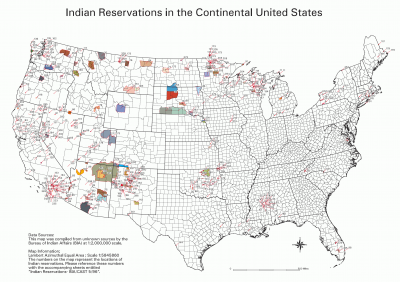
There are a large number of roads, particularly in the western half of the United States, that are located on American Indian Reservations. There are about 310 such reservations as reviewed by the United States Department of the Interior's (DOI) Bureau of Indian Affairs (BIA). While the map shows only only the continental United States, reservations exists in Alaska and Hawaii. Navajo Nation is the largest and is about the same size as West Virginia. Twelve of the reservations are larger than Rhode Island. Wikipedia maintains a list of the largest Indian reservations and the states in which they are located.
These roads may be a mix of US government, public, tribal, and some private roads. Because most tribal lands are considered independent government entities, coordination and uniformity are not always clear. Public roads provide access to and within Indian reservations, Indian trust land, restricted Indian land, and Alaska native villages. Approximately 29,000 miles are under the jurisdiction of BIA and tribes and another 73,000 miles are under State and local ownership.
Waze & Reservation Roads
Tribal lands and Native American Reservations have resident communities that will utilize Waze, they are a destination for tourism, and they may be a critical viable route for travel through a region. Casinos are also located on a large number of reservations across the country, which will add more regular traffic to those regions. Because of this Waze editors should be concerned with a robust representation of roads and landmark content for these areas in the Waze Map.
On the other hand, Native American lands are private and contain many areas that the local population and their law enforcement do not want the general public traveling. Because of this, we wish to avoid mapping private roadways or need to ensure they are marked with Private Roads whenever possible.
This page provides some guidance on editing roads on these reservations as we seek to achieve these things in Waze editing:
- Common or standardized naming of roads
- Preventing routing through private roads
- Functional classification of roads to Waze road types
- Identifying critical landmarks for navigation and destinations.
Bureau of Indian Affairs (BIA)
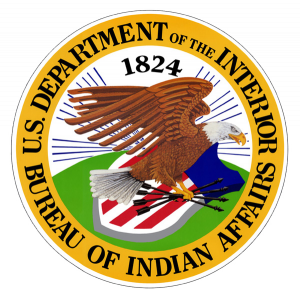
With respect to Waze editing, Bureau of Indian Affairs (BIA) is an integrating agency that spans some aspects of most tribe road systems in the United States. A part of the US Department of the Interior (DOI), Indian Affairs (IA) the oldest bureau in DOI, Established in 1824. It services aspects of about 566 federally recognized American Indian tribes and Alaska Natives and administration and management of 55 million surface acres and 57 million acres of subsurface minerals estates held in trust by the United States for American Indian, Indian tribes, and Alaska Natives.
BIA provides many services. Waze editors will have most interest in their Division of Transportation. See the References section below for specific links to mapping resources at BIA. Note that BIA does not control the Native American Tribe roads, it provides some funding and some coordination. An key point for Waze editors is that all BIA roads are open to the public.
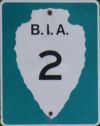
Native Tribes may enter their roads into the BIA road system. In return they obtain maintenance and other services for those roads. These roads, by definition, are to be open to the public and marked with BIA road signs at least at the beginning and end of each route. These signs are of the type shown to the left, and arrowhead with this particular shape. Not all roads are marked with these signs. Many Native American Tribe road maps, such as those from the Navajo Nation, will identify BIA roads.
Reservation Road Naming
As mentioned elsewhere in this article, the types of roads on an Indian Reservation can be of many types and coordination among Reservations and road-naming officials are not always clear. Because of this the following order of preference is suggested in how to name roads on an Indian Reservation unless there is a specific reservation standard:
- Shared government road names
- US Freeways, US Highways, State Highways, County Roads
- As marked locally on signage (check in person or use Street View)
- Example, "Navajo Route xxx" or "N-xxx"
- Through standard route designations with common format
- BIA-xxx for roads in the BIA system
- IRR-xxx for roads with a route designation within the IRR system
- NTR-xxx for Native Tribal Road
Waze base map naming conventions have been found to be somewhat random in rural areas. For example, a particular road may be named "Indian Service Route XXX," "Indian Service Rte XXX," "Indian Svc Rte XXX," or "IS Rt XXX" along its length. Without higher-level precedent in the above list, it is suggested these all be named "IRR-xxx" for that road.
Specific Reservation Standards
Certain Indian Reservations, particularly those with larger regions, may have standards or preferences for road naming. This section is intended to identify those standards.
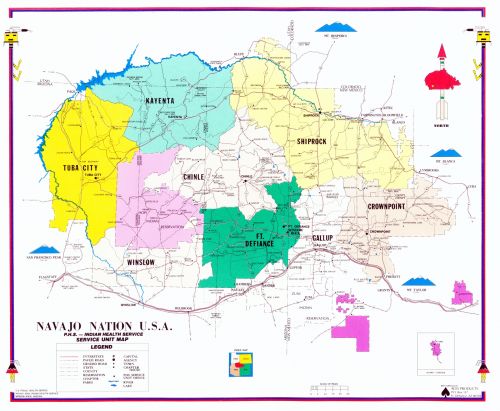
Located in Arizona, Utah, and New Mexico, the Navajo Nation is about the size of West Virginia and more than three times the land area of the next largest reservation and has ten times the total population. The Navajo Nation completely surrounds the Hopi Reservation. It is divided into regions called "Agencies." These are the Central, Eastern, Northern, Ft. Defiance, and Western Agencies. Within each agency are smaller regions called "Chapters." For instance, within the Central agency is the Black Mesa Chapter. As with many Native American Reservations, it is also segmented by county boundaries and contains federal, county, and local government roads in addition to tribal roads.
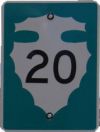
The Navajo Nation has a Department of Transportation that has significant map resources (see references below). This reservation has had names on the base map such as "Navajo Service Route," "Navajo Route," and others. Roads that are not part of BIA or other government entities are often marked with signs "N xxx" or an arrowhead (of the shape shown to the left) with a route number.
<still researching>
Reservation Road Typing
The choice of road types (street, primary street, highway, etc.) for Indian Reservations, particularly those that are rural, may be different from urban areas. Many dirt roads are considered essential, are well maintained, and well traveled. These roads, although made of dirt, might be considered streets or primary streets in the region. If these roads are marked as dirt, they would be rendered less likely by Waze for routing.
Specific functional classification of Indian reservation roads may be found, in part, through the BIA database. This functional classification is not identical to Waze and other municipalities. The coding guide can be found at the BIA link above; the classification table is reproduced here for convenience.
Note that this table does not include detail on federal, state, and county roads that might be located on tribal lands. Please see pages Road types and Road names for more information.
| Number | Description | Suggested Waze Type |
| 1 | Major arterial roads providing an integrated network with characteristics for serving traffic between large population centers, generally without stub connections and having average daily traffic volumes of 10,000 vehicles per day or more with more than two lanes of traffic. | Minor Hwy |
| 2 | Rural minor arterial roads providing an integrated network having the characteristics for serving traffic between large population centers, generally without stub connections. May also link smaller towns and communities to major resort areas that attract travel over long distances and generally provide for relatively high overall travel speeds with minimum interference to through traffic movement. Generally provide for at least inter-county or inter-state service and are spaced at intervals consistent with population density. This class of road will have less than 10,000 vehicles per day. | Primary Street |
| 3 | Streets that are located within communities serving residential areas. | Street |
| 4 | Rural major collector road is collector to rural local roads. | Street or Primary Street |
| 5 | Rural local road that is either a section line and/or stub type roads, make connections within the grid of the IRR system. This class of road may serve areas around villages, into farming areas, to schools, tourist attractions, or various small enterprises. Also included are roads and motorized trails for administration of forests, grazing, mining, oil, recreation, or other use purposes. | Street |
| 6 | City minor arterial streets that are located within communities, and serve as access to major arterials. | Street |
| 7 | City collector streets that are located within communities and serve as collectors to the city local streets. | Street or Primary Street |
| 8 | This class encompasses all non-road projects such as paths, trails, walkways, or other designated types of routes for public use by foot traffic, bicycles, trail bikes, snowmobiles, all terrain vehicles, or other uses to provide for the general access of non-vehicular traffic. | Walking Trail |
| 9 | This classification encompasses other transportation facilities such as public parking facilities adjacent to IRR routes and scenic byways, rest areas, and other scenic pullouts, Ferry boat terminals, and transit terminals. | Street, Parking Lot |
| 10 | This classification encompasses airstrips that are within the boundaries of the IRR system grid and are open to the public. These airstrips are included for inventory and maintenance purposes only. | Runway/Taxiway |
| 11 | This classification indicates an overlapping or previously inventoried section or sections of a route and is used to indicate that it is not to be used for accumulating needs data. This class is used for reporting and identification purposes only. | Street or Do not map |
Landmarks: Point Places, Area Places
Landmarks on Indian Reservations should generally follow guidance for all landmarks in the United States. Native American Tribes are very sensitive to providing landmarks to facilities that are not publicly available, especially religious and archaeological sites. Do not map such sites.
Specific guidance for Indian Reservations is as follows:
Area and Point Places to Consider
- Visitor centers
- Casinos (Map building and parking lot)
- Tourist attractions
- Gas / Food / Lodging
- Airports
- Schools
Area and Point Places to Avoid
- Private religious areas
- Private ceremonial areas
- Archaeological sites
- Tribal-only medical and other service centers
- Other private areas and roads
It may seem tempting to map Tribal-only medical and other centers as a safety or convenience issue. It has been found to cause problems for tribes when these are mapped and the general public arrives at them to seek services that are not publicly available. Therefore please do not map these locations with Places.
References
List of Indian Reservations
Wikipedia provides a List of Indian Reservations that might be useful at finding tribe-specific and reservation-specific details such as tourist attractions for landmarks, road names, etc.
BIA Tribal Transportation Program (TPP) - (formerly Indian Reservation Road (IRR) Program)
Details about the BIA's Tribal Transportation Program can be found at their website. Utility of this information is that it provides access to a list of roads, although obscure, that might be useful in Waze editing. Roads that are entered into the IRR Program are by definition publicly accessible. Therefore this is a good source of roads that should be mapped in Waze.
The IRR Inventory is a database of all transportation facilities eligible for IRR Program funding and therefore will indicate ownership, the route number, may indicate that a BIA-xxx name is appropriate for a road, and identify the classification. The database is full of other information not relevant to Waze editing such as bridge numbers, traffic volumes, and maintenance responsibility.
Tribal GIS
TribalGIS.com is a site that is intended to serve tribal personnel, tribal members, faculty and students of tribal colleges/universities. As such, it is not targeting general public interest but rather Native American Nations and related organizations. It includes a Tribal GIS Interactive Map Server that may be particularly useful at identifying Native American Nations, Tribes, and Pueblos in the United States. It does show roadways.
Arizona Tribal Transportation
The Arizona Tribal Transportation website is designed as a central location for state-tribal transportation related partnerships, projects, activities, groups, links, and other related information.
The Navajo Nation has the largest inventory of roads of all Indian reservations. Resources include the Navajo Division of Transportation website and the Navajo Airports website.
Of particular use to the Waze Editor for the Navajo Nation will be the Navajo DOT Maps webpage where you can find the Navajo Nation definition of tribal roads, BIA roads, IRR Inventory roads, as well as State and US Highways.
Similar Road Systems
Additional References
(1) Discussions with BIA staff.
(2) Discussions with various Native American Tribe GIS staff.
(3) Discussions with TribalGIS.com staff.